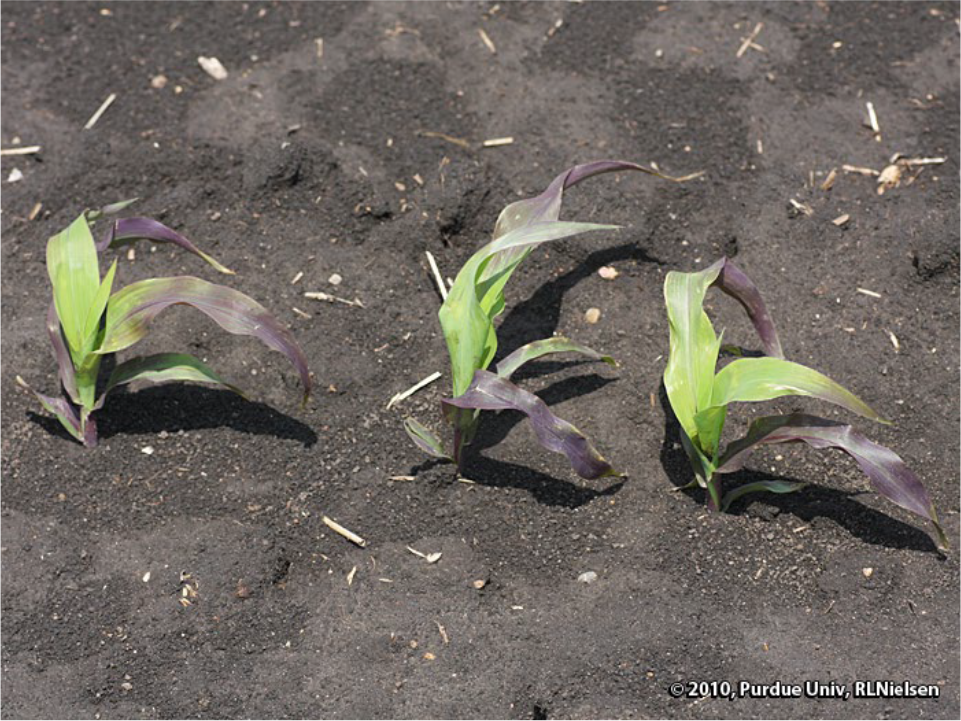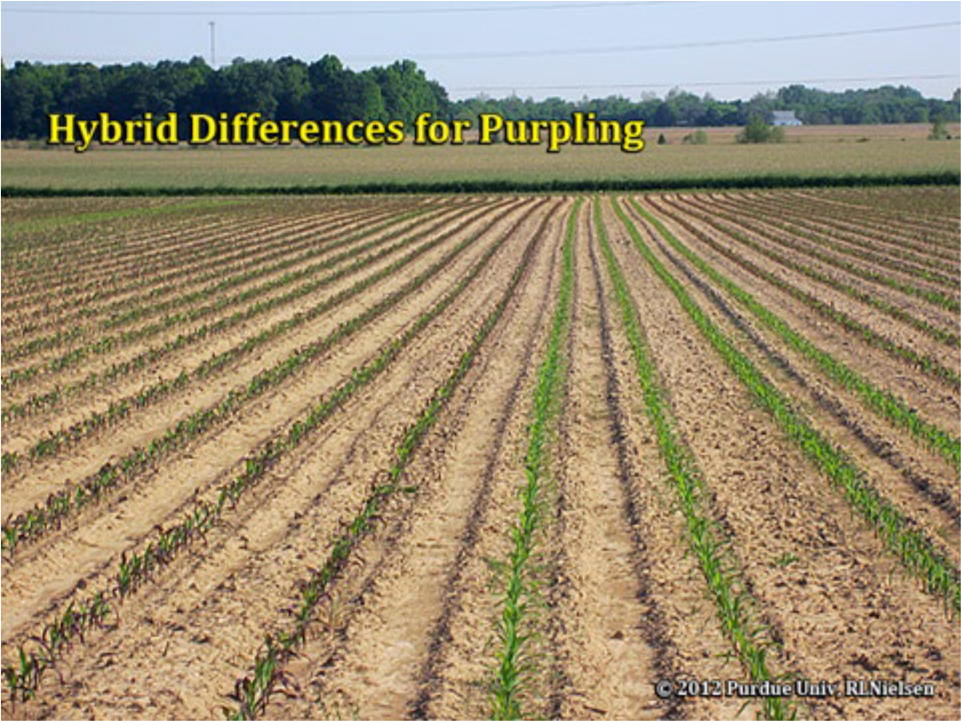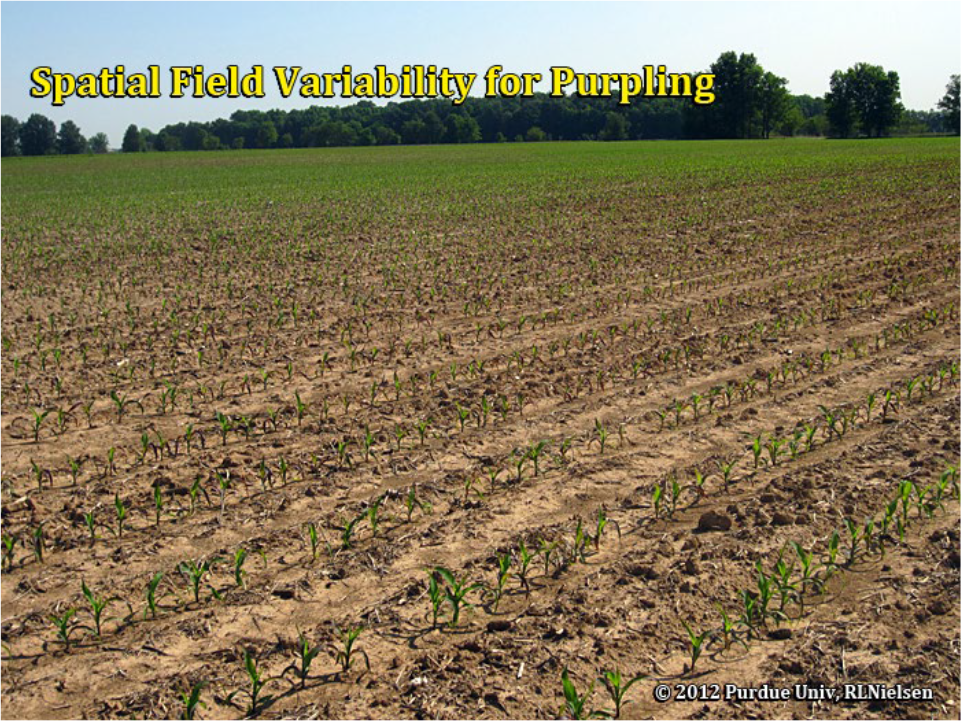⇦ Back to Crop Management Home
¶ Introduction
Corn seedlings that have a purplish tint are not unusual. However, farmers are often concerned that it is a problem which will affect crop yield and profits. What are the causes of the "purple corn syndrome"?
Red and purple colors in plants are caused by the accumulation of natural plant pigments called “anthocyanins” (see Figure 1). The only known function of anthocyanins is as color attractants in fruits and flowers.
Anthocyanin production is controlled genetically. A hybrid may have none, one, or many of the anthocyanin genes. These genes are often controlled or triggered by environmental stresses that limit the plants' ability to fully utilize the photosynthates produced during the day.
The complete set of genes for anthocyanin production must be present or purpling will not occur. This is why two corn hybrids planted in the same field may differ in their degree of purpling. Hybrids with more anthocyanin-producing genes will purple more greatly than those with fewer “purpling” genes.
¶ Figure 1. Purpling of Lower Corn Leaves

¶ Causes of Purpling
Purpling of corn seedlings is usually triggered by early season growth stresses, usually occurring the in the V3 to V6 stages (3- to 6-leaf collar stages). Many of these stresses can be managed, but some of the causes of purple corn are beyond a farmer's control.
Remember that a corn hybrid must have the genetic ability to produce anthocyanins before purpling occurs. Research has shown the anthocyanin pigment is produced only on the surface layer of cells and does not affect the chlorophyll content in the leaf.
¶ Temperature:
Cool soil and air temperatures are the most common cause of purpling of corn seedlings. A combination of bright, sunny days and less than favorable cool nights (40's to 50's F) will often trigger anthocyanin-producing hybrids to exhibit some purpling. These plants may acquire the purple color in just a few days, explaining the "overnight" response farmers describe.
¶ Soil fertility:
Phosphorus deficiency is typically characterized by purpling of plants. If the condition persists past early growth stages, plant tissue analysis can verify a suspected deficiency.
Purpling occurs as patches in the field for most phosphorus deficiency situations, indicating that soil phosphorus levels may be limiting. A good soil testing and fertility program can correct or prevent phosphorus deficiency problems.
¶ Hybrid:
Some hybrids are better able than others to withstand particular stresses. Farmers should select hybrids that perform well under local conditions.
¶ Soil type:
Soil variability may cause uneven growth by affecting root growth. Soils with a high clay content are more prone to compaction and usually warm slower because they stay wet. Plants growing in field areas that are eroded or have high calcium carbonate (free lime) may be under stress.
¶ Tillage:
Certain tillage systems may create soil conditions that are less that optimum for stand establishment and growth. No-till and other reduced tillage systems may have less uniform seedbeds, creating variation in aeration, seed coverage and planting depth. Reduced tillage leaves more residue on the surface, thus insulating the soil, delaying warming, and keeping soil temperatures cool. Soils that are over-tilled may be loose and dry, resulting i variable germination and establishment.
¶ Compaction:
Soil compaction can limit root growth and reduce nutrient uptake. Avoiding tillage operations when soils are wet will help prevent compaction.
¶ Pesticides:
Carryover and misapplication of certain soil-applied herbicides can injure roots and affect plant growth. Streaks or spots of uneven growth are typical when misapplication occurs.
¶ Pests:
Insects and diseases that attack roots and seedlings reduce the plant's ability to take up nutrients and moisture.
¶ Significance of Purpling
Is a purpled corn field a real problem? In most instances the purpling will have been caused by the combination of bright,sunny days and cool nights. The purpling will disappear as the plants develop further, often after the 6-leaf stage, with no yield impact.
The tendency of a corn hybrid to turn purple or not will not be an indicator of its performance. A Minnesota study evaluated the effect of cool weather-induced purpling. They compared the yields in 114 yield comparisons with two hybrids from the same company, both with the same maturity.
Hybrid A had the full set of anthocyanin purpling genes; hybrid B had none. Even though hybrid A turned purple, it outyielded hybrid B by an average of 7.9 bushels per acre.
Corn hybrids that turn purple might actually be considered to be better indicators of growth stresses. A hybrid that purpleswill show when there are stress problems that may need to be dealt with. If a hybrid does not have the genetic makeup to purple when under stress, yield-reducing problems may go undetected.
If the purpling is due to a restricted root system, then the potential yield impact will depend on whether the restriction is temporary (e.g., cool temperatures and wet soils) or more prolonged (e.g., soil compaction, herbicide injury).
Young plants can recover from temporary root restrictions with little to no yield effect. If the stress lingers and plants become stunted, then some yield loss may occur. This loss is not due to the purpling itself, but rather because of the extended effect restricted roots and stunted plants.
If the purpling is due to the hybrid's genetic response to weather stress, the purpling symptoms will be more uniform across the field (see Figure 2). If other stresses are also restricting root development and/or function, then the purpling symptoms may be more variable across the field (see Figure 3). The symptoms may be correlated to soil type, drainage characteristics, or elevation.
It may be upsetting to see purple corn plants may be upsetting. In most situations, the symptoms are likely to be due to cool weather, with little or no effect on yield. When other stress factors are triggering the condition, they should be identified and corrected, if possible.
¶ Figure 2. Purpling Due to Hybrid Genetic Differences

¶ Figure 3. Purple Color Varies Across Field.

¶ References
Nielsen, R.L. 2022. Prevalent Purple Plants Perennially Puzzle Producers. Purdue University Extension, West Lafayette, IN. accessed 01July2022. http://www.kingcorn.org/ news/timeless/PurpleCorn.html
Silva, G. 2016. Purple corn syndrome: What causes purple coloration of corn? Michigan State Univ. Ext., East Lansing, MI. accessed 01July2022. https://www.canr.msu.edu/news/purple_corn_syndrome_what_causes_purple_coloration_of_corn